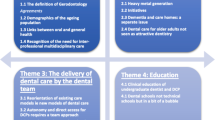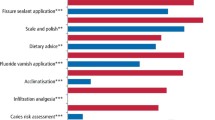Abstract
Objectives To explore the level and nature of dental care provided by dental hygienists and therapists to older adults (65 and over) and to identify barriers to such care.
Methods An online survey of all GDC-registered hygienists and therapists in Scotland.
Results Thirty-two percent (196 of 609) responded. Seventy-five percent worked in general dental practice. Nearly two-thirds of the workload of those in general dental practice was with older patients. Most reported that numbers of such patients were increasing. Fifty-seven percent worked to inflexible appointment slots of 15 or 30 minutes. Time pressure, consent to treatment and power of attorney were the worst administrative problems in the workplace.
Only one in four, mainly Public Dental Service (PDS) employees, provided domiciliary care or treated patients in care homes. Common problems in these settings were: poor hygiene, communicating with patients, capacity to consent, power of attorney, insufficient training and time, poor staff liaison, lack of support staff, space and equipment, poor denture storage/maintenance, co-morbidity and NHS charges exemption.
Hygienist-therapists, who have a much wider clinical remit than hygienists, often felt their work with older people did not fully utilise their training. There was considerable demand for further training related to the care of older people, with dementia-related training being the most often specified. There was also support for greater professional autonomy through working on a direct access basis and having an NHS list number.
Conclusion Respondents working in general practice saw a large proportion of older patients in the practice, while domiciliary and care home visits were largely undertaken by PDS workers. Findings support the conclusion that hygienist-therapists in particular, given their increasing numbers in the UK dental workforce, may be currently under-used in meeting the demand for prevention and treatment of older patients. The combination of demographic and clinical pressure may be met more effectively and economically by developing such 'mid-level' clinical roles in new models of dental care.
This is a preview of subscription content, access via your institution
Access options
Subscribe to this journal
Receive 24 print issues and online access
$259.00 per year
only $10.79 per issue
Buy this article
- Purchase on Springer Link
- Instant access to full article PDF
Prices may be subject to local taxes which are calculated during checkout




Similar content being viewed by others
References
National Records of Scotland. Mid-Year Population Estimates: Scotland, Mid-2018. 2019. Available at https://www.nrscotland.gov.uk/statistics-and-data/statistics/statistics-by-theme/population/population-estimates/mid-year-population-estimates (accessed April 2020).
National Records of Scotland. Population Projections for Scottish Areas (2014-based). 2016. Available online at https://www.nrscotland.gov.uk/statisticsanddata/statistics/statisticsbytheme/population/population-projections/subnationalpopulation-projections/2014-based (accessed April 2020).
NHS Scotland. Primary Care Dentistry in Scotland: Annual Report 2017/18. 2018. Available at https://www.isdscotland.org/Health-Topics/Dental-Care/Publications/2018-10-30/2018-10-30-SDPB-Report.pdf?3554934264 (accessed April 2020).
NHS Scotland. Care Home Census for Adults in Scotland: Figures for 2007-2017 (as at 31 March). 2018. Available at https://www.isdscotland.org/Health-Topics/Health-and-Social-Community-Care/Publications/2018-09-11/2018-09-11-CHCensus-Report.pdf?2721804381 (accessed April 2020).
NHS Health Scotland. Caring for Smiles: Guide for Care Homes. 2013. Available at http://www.knowledge.scot.nhs.uk/media/7460397/caringforsmilescarehomes2013.pdf (accessed April 2020).
Scottish Government. Oral health improvement plan. 2018. Available online at https://www.gov.scot/publications/oral-health-improvement-plan/ (accessed April 2020).
Sweeney M P, Williams C, Kennedy C, Macpherson L M, Turner S, Bagg J. Oral health care and status of elderly care home residents in Glasgow. Community Dent Health 2007; 24: 37-42.
Bennet J A, Thomas V, Reigel B. Unrecognised chronic dehydration in older adults: examining prevalence rate and risk factors. J Gerontol Nurs 2004; 30: 22-28.
NHS Education for Scotland. The Dental Workforce in Scotland 2016. 2016. Available at https://www.nes.scot.nhs.uk/dental-workforce1.html (accessed April 2020).
Naughton D K. Expanding oral care opportunities: direct access care provided by dental hygienists in the United States. J Evid Based Dent Pract 2014; DOI: 10.1016/j.jebdp.2014.04.003.
Jisc. Online surveys. Available online at https://www.onlinesurveys.ac.uk/ (accessed April 2020).
General Dental Council. Preparing for practice: Dental team learning outcomes for registration (2015 revised edition). 2015. Available at https://www.gdc-uk.org/docs/default-source/quality-assurance/preparing-for-practice-(revised-2015).pdf (accessed April 2020).
Turner S, Tripathee S, McGillivray S. Direct access to DCPs: What are the potential risks and benefits? Br Dent J 2013; 215: 577-582.
Turner S, Ross M. Direct access: how is it working? Br Dent J 2017; 222: 191-197.
Watt R G, Daly B, Allison P et al. Ending the neglect of global oral health: time for radical action. Lancet 2019; 394: 261-272.
Wing C, Marier A. Effects of occupational regulations on the cost of dental services: evidence from dental insurance claims. J Health Econ 2013; 34: 131-143.
Wanyonyi K L, Radford D R, Harper P R, Gallagher J E. Alternative scenarios: harnessing mid-level providers and evidence-based practice in primary dental care in England through operational research. Hum Resour Health 2015; 13: 78.
Simmer-Beck M, Walker M, Gadbury-Amyot C, Liu Y, Kelly P, Branson B. Effectiveness of an Alternative Dental Workforce Model on the Oral Health of Low-Income Children in a School-Based Setting. Am J Public Health 2015; 105: 1763-1769.
Evan C, Chestnutt I G, Chadwick B L. The potential for delegation of clinical care in general dental practice. Br Dent J 2007; 203: 695-699.
Monaghan N P, Morgan M Z. What proportion of dental care in care homes could be met by direct access to dental therapists or dental hygienists? Br Dent J 2015; 219: 531-534.
Author information
Authors and Affiliations
Corresponding author
Electronic supplementary material
Rights and permissions
About this article
Cite this article
Turner, S., Symeonoglou, P. & Ross, M. The delivery of dental care to older adults in Scotland: a survey of dental hygienists and therapists. Br Dent J (2020). https://doi.org/10.1038/s41415-020-1790-5
Published:
DOI: https://doi.org/10.1038/s41415-020-1790-5
This article is cited by
-
Expert view: Steve Turner
British Dental Journal (2022)



